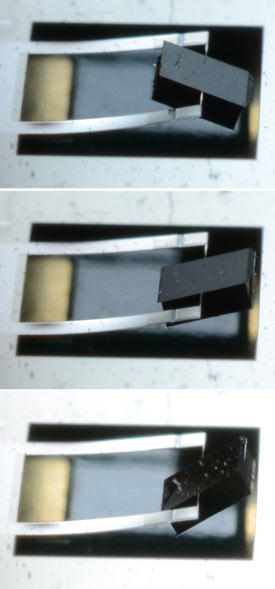

01/25/2016

© 2016 WILEY-VCH Verlag GmbH & Co. KGaA, Weinheim
The fragility of silicon after it has been subjected to microprocessing limits the use of silicon-based microelectromechanical systems, or ‘MEMS’, in devices with large rotational movements. Now, by exploiting the high robustness of metallic glasses, AIMR researchers have constructed a MEMS device that boasts an ultrahigh rotational performance as well as a very low power consumption, making it attractive for next-generation sensors and actuators1.
Metallic glasses are alloys that are characterized by a non-crystalline structure and a low elastic modulus. Yu-Ching Lin first encountered them when she joined the AIMR at Tohoku University, and she was immediately struck by their potential for MEMS. “Metallic glasses are amorphous and are very strong on micro and nanoscales,” she explains. “I thought they would be very promising for MEMS, which need tough micro and nanostructures to prevent breakage during actuation.”
Lin realized that, because they have lower elastic moduli than silicon, metallic glasses could be used to realize a higher degree of movement in MEMS. This is exciting for sensing and actuating applications, since larger deflections mean higher performance.
To test this idea, Lin and her collaborators constructed a microscanner that contained a zirconium-based metallic glass (see image). The scanner had a large rotation angle of 146 degrees at a low power consumption in the microwatt range. Lin notes that it would be exceedingly difficult to realize such a large deflection angle and low power consumption simultaneously in a silicon-based MEMS.
To explore the potential of the scanner, the team deployed it as part of an optical coherence tomography imaging system, which they used to obtain images of a human finger. The metallic-glass MEMS scanner obtained images at a lateral resolution about ten times better than silicon-based scanners reported in the literature, says Lin. “Many MEMS researchers are developing microscanners for optical coherence tomography imaging based on silicon, with very slow scanning speeds.”
Its high performance and enviably low power consumption make MEMS fabricated from metallic glasses promising for emerging wearable technology, for which fast-draining batteries are a concern. Looking further ahead, “if we can combine our device with a self-generation device, maybe in the future we won’t even need a battery,” says Lin.
Lin notes that both metallic glasses and MEMS are strong research fields at Tohoku University, and that working at the AIMR has enabled her and her collaborators to bridge the two fields and create this novel metallic-glass MEMS device.
Lin, Y.-C., Tsai, Y.-C., Ono, T., Liu, P., Esashi, M., Gessner, T. & Chen, M. Metallic glass as a mechanical material for microscanners. Advanced Functional Materials 25, 5677–5682 (2015). | article
This research highlight has been approved by the authors of the original article and all information and data contained within has been provided by said authors.